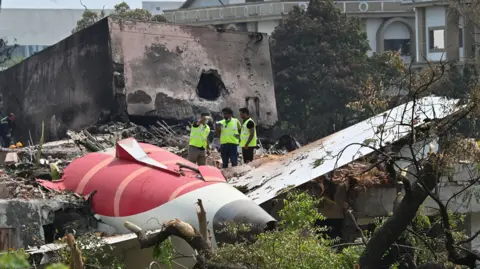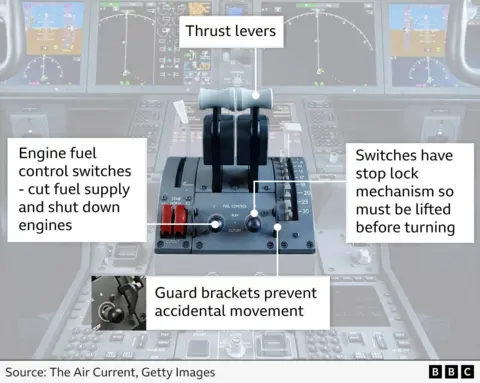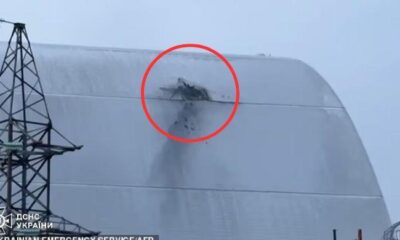Business
Blame game over Air India crash goes on

Theo LeggettInternational Business Correspondent
 Getty Images
Getty ImagesNearly five months after a plane crash in India which killed 260 people, the investigation has become mired in controversy – with the country’s Supreme Court the latest to weigh in.
Flight 171 was en route to London from Ahmedabad in western India on 12 June. It crashed into a building just 32 seconds after taking off.
An interim report was released in July, but critics argue it unfairly focused on the actions of the pilots, diverting attention away from a possible fault with the aircraft.
On Friday, a judge in India’s Supreme Court insisted that nobody could blame the aircraft’s captain.
His comments came a week after the airline’s boss insisted there was no problem with the aircraft.
During a panel discussion at the Aviation India 2025 summit in New Delhi in late October, Air India’s chief executive Cambell Wilson admitted that the accident had been “absolutely devastating for the people involved, for the families of those involved, and the staff”.
But he stressed that initial investigations by Indian officials, summed up in a preliminary report, had “indicated that there was nothing wrong with the aircraft, the engines or the operation of the airline”.
He added although Air India was working with investigators it was not involved directly.
Because the accident happened in India, the investigation is being led by the country’s Air Accident investigation Bureau (AAIB). However, because the aircraft and its engines were designed and built in America, US officials are also taking part.
A month after the accident, the AAIB published a preliminary report. This is standard procedure in major accident investigations and is meant to provide a summary of the known facts at the time of publication.
The report will typically draw on information gleaned from examination of the crash site, for example, as well as basic material downloaded from the flight data recorder. It will not normally make firm conclusions about the cause of the accident.
However, the 15-page report into Air India 171 has proved controversial. This is largely due to the contents of two short paragraphs.
First, it notes that seconds after takeoff, the fuel cutoff switches – normally used when starting the engines before a flight and shutting them down afterwards – had been moved from the “run” to the cutoff position.
This would have deprived the engines of fuel, causing them to lose thrust rapidly. The switches were moved back to restart the engines, but too late to prevent the disaster.
It then says: “In the cockpit voice recording, one of the pilots is heard asking the other why did he cutoff. The other pilot responded that he did not do so.”

That indirectly-reported exchange sparked intense speculation about the role of the two pilots, Captain Sumeet Sabharwal and his first officer Clive Kunder, who was flying the plane at the time.
A former chair of the National Transportation Safety Board, Robert Sumwalt, claimed the report showed “this was not a problem with the airplane or the engines”.
“Did somebody deliberately shut down the fuel, or was it somehow or another a slip that they inadvertently shut off the fuel?” he said during an interview with the US network CBS.
Indian aviation safety consultant Capt. Mohan Ranganathan strongly implied that pilot suicide could have caused the accident, in an interview with the country’s NDTV channel.
“I don’t want to use the word. I’ve heard the pilot had some medical history and… it can happen,” he said.
Mike Andrews, a lawyer acting on behalf of victims’ families, thinks the way in which information has been released has “led people unfairly and inappropriately to blame those pilots without all the information”.
“An aircraft like this – that is so complex – has so many things that could go wrong,” he explains.
“To seize upon those two very small, decontextualised pieces of information, and automatically blame pilots for suicide and mass murder… is unfair and wrong.”
That view is echoed by Capt. Amit Singh, founder of the Safety Matters Foundation, an organisation based in India that works to promote a safety culture in aviation.
He has produced a report which claims the available evidence “strongly supports the theory of an electrical disturbance as the primary cause of the engine shutdown” that led to the disaster.
He believes an electrical fault may have caused the Full Authority Digital Engine Control (FADEC), a computerised system which manages the engines, to trigger a shutdown by cutting off the fuel supply.
Meanwhile the flight data recorder, he suggests, may have registered the command to shut off the fuel supply, rather than any physical movement of the cutoff switches in the cockpit.
In other words, the switches themselves may not have been touched at all, until the pilots tried to restart the engines.
Capt. Singh has also challenged the way in which the investigation has been carried out in India’s Supreme Court.
He told the BBC the way in which the preliminary report was framed was biased because it “appears to suggest pilot error, without disclosing all the technical anomalies that occurred during the flight”.
Meanwhile the Supreme Court itself has already commented on the issue.
It has been considering a petition filed by Pushkarraj Sabharwal, the father of Capt. Sumeet Sabharwal. The 91-year-old has been seeking an independent judicial inquiry into the tragedy.
“It’s extremely unfortunate, this crash, but you should not carry this burden that your son is being blamed. Nobody can blame him for anything,” Justice Surya Kant told him.
A further hearing is expected on 10 November.
‘Flat out wrong’
The theory that an electrical fault could have caused the accident is supported by the US-based Foundation for Aviation Safety (FAS).
Its founder is Ed Pierson, a former senior manager at Boeing, who has previously been highly critical of safety standards at the US aerospace giant.
He believes the preliminary report was “woefully inadequate… embarrassingly inadequate”.
His organisation has spent time examining reports of electrical issues on board 787s. They include water leaks into wiring bays, which have previously been noted by the US regulator, the Federal Aviation Authority. Concerns have also been voiced in some other quarters.
“There were so many of what we consider electrical oddities on that plane, that for them to come out and to all intents and purposes direct the blame to the pilots without exhaustively going through and examining potential system failures, we just thought was flat out wrong,” he says.
He believes there was a deliberate attempt to divert attention away from the plane and on to the pilots.
The FAS has called for wholesale reform of current international air accident investigation procedures, citing “outdated protocols, conflicts of interest and systemic failures that endanger public trust and delay life-saving safety improvements”.
‘Keeping an open mind’
Mary Schiavo, an attorney and former inspector general at the US Department of Transportation, disagrees that the pilots have been deliberately put under the spotlight.
She thinks the preliminary report was flawed, but only because investigators were under intense pressure to provide information, with worldwide attention focused on them.
“I think they were just in a hurry, because this was a horrific accident and the whole world was watching. They were just in a hurry to push something out,” she says.
“Then, in my opinion, the whole world jumped to conclusions and right away was saying, ‘this is pilot suicide, this was intentional’.
“If they had to do it over again, I don’t think they would have put those little snippets from the cockpit voice recording in,” she says.
Her own view is that “a computer or mechanical failure… is the most likely scenario”.
International rules for air accident investigations stipulate that a final report should appear within 12 months of the event, but this is not always adhered to. However, until it is published, the true causes of the accident will remain unknown.
A former air accident investigator who spoke to the BBC emphasised the importance of “keeping an open mind”, until the process has been completed.
Boeing has always maintained that the 787 is a safe aircraft – and it does have a strong record.
The company told the BBC it would defer to India’s AAIB to provide information about the investigation.
Business
SFIO probes IndusInd’s Rs 1,960 crore derivatives hole – The Times of India

MUMBAI: Serious Fraud Investigation Office (SFIO) has opened a formal probe into IndusInd Bank after a Dec 23, 2025 letter triggered an investigation under the Companies Act, 2013, over accounting lapses tied to internal derivative trades.In a filing, the bank said SFIO, under the MCA, seeks information after the lender flagged on June 2 issues spanning internal derivatives, unsubstantiated “other assets/liabilities”, and microfinance interest/fee income. It disclosed the update on Dec 18, pledged full cooperation, and posted details on its website.Derivatives irregularities have hit P&L by about Rs 1,960 crore as of March 31, 2025, eroding reported net worth by roughly 2.3% as of Dec 2024. Earlier profits were overstated as notional gains flowed into P&L while losses sat parked as assets, inflating NII and earnings quality. The derivatives irregularities saw several members of the senior management stepping down with the board bringing in Rajiv Anand from Axis Bank to head the private lender.The bank recognised the losses, absorbed pain in its FY25 earnings which tipped the bank into a Q4 FY25 net loss after one-off write-offs/provisions. Capital/net worth took a 2–2.5% post-tax hit, trimming buffers and nudging growth appetite and capital pricing.The derivatives loss resulted in the shares of the bank sliding as investors reassessed earnings credibility and governance. The scrutiny also sharpened on the board/management/audit committees, intensifying regulatory pressure and SFIO oversight.
Business
Navi Mumbai airport opens today with 30 domestic flights – The Times of India

MUMBAI: Navi Mumbai International Airport (NMIA) opens to commercial operations on Thursday after years of missed deadlines, opening a second gateway for air travel in the Mumbai region. The day will see four airlines operating about 30 domestic flights at India’s newest greenfield airport. The first scheduled arrival will be an IndiGo flight from Bengaluru, touching down at 8 am, while the first departure will also be operated by IndiGo, a morning service from Navi Mumbai to Hyderabad, scheduled to take off at 8.40 am. The terminal building will open to departure passengers around 6.40 am, said an NMIA spokesperson.“On Day One, domestic services will be operated by IndiGo, Air India Express, Akasa Air and Star Air connecting NMIA to nine destinations across India. The airport will handle 15 scheduled departures on the first day,” said an NMIA spokesperson.“During the initial phase, NMIA will operate between 8 am and 8 pm, with up to 24 scheduled daily departures to 13 destinations and the capability to manage up to 10 aircraft movements per hour. From Feb 2026, operations are planned to progressively scale up to round-the-clock services,” the spokesperson added. “Passenger services from day one will be supported by Digi Yatra-enabled contactless processing at designated touchpoints, along with trained terminal staff across kerbside, check-in, security and boarding areas,” the spokesperson said. Conventional check-in counters too will be available for passengers not opting for Digiyatra. Retail and food and beverage offerings have been curated with a focus on affordability and local preferences, the airport said.In its initial phase, NMIA opens with terminal 1 and one operational runway; the terminal building has a capacity to handle 20 million passengers annually, but it is expected to touch that number before mid-2026. The terminal building can accommodate about 2-3 million passengers beyond its declared capacity. The new airport is 45-50 km from North Mumbai, 35-40 km from South Mumbai and 35-45 km from the eastern suburbs.
Business
Logistics IPO: Yatayat Corporation files Sebi papers to raise funds; growth surge puts road freight firm in focus – The Times of India

Logistics and transportation services provider Yatayat Corporation India Ltd has filed draft papers with markets regulator Sebi to raise funds through an initial public offering, as the road freight segment continues to see strong demand, PTI reported.According to the draft red herring prospectus (DRHP), the proposed IPO will comprise a fresh issue of up to 77 lakh equity shares along with an offer for sale (OFS) of up to 56 lakh equity shares by a promoter, taking the total offer size to as many as 1.33 crore shares.The company said proceeds from the fresh issue will be used primarily to meet working capital requirements and for general corporate purposes.Yatayat Corporation operates in the road logistics space, with a focus on Full Truck Load (FTL) transportation, offering point-to-point freight movement across major logistics corridors in the country. Its operations are supported by a network of 34 branches and one warehouse spread across 12 states.The company services a diversified client base spanning agriculture and agri-inputs, building materials and construction, chemicals and allied industries, energy and power, engineering and industrial manufacturing, IT and technology solutions, metals and mining, textiles and apparel, as well as other industrial and consumer segments.On the financial front, Yatayat Corporation reported revenue from operations of Rs 448.13 crore in FY25, up from Rs 348.34 crore in FY24. Profit after tax rose to Rs 30 crore in FY25, compared with Rs 15 crore in the previous financial year.Unistone Capital has been appointed as the sole book-running lead manager to the issue, the draft papers showed.
-

 Fashion7 days ago
Fashion7 days agoIndonesia’s thrift surge fuels waste and textile industry woes
-

 Tech7 days ago
Tech7 days agoT-Mobile Business Internet and Phone Deals
-

 Business7 days ago
Business7 days agoBP names new boss as current CEO leaves after less than two years
-

 Sports7 days ago
Sports7 days agoPKF summons meeting after Pakistani player represents India in kabaddi tournament
-

 Entertainment7 days ago
Entertainment7 days agoIndia streamlines visa rules in boost for Chinese professionals
-

 Sports7 days ago
Sports7 days agoUWCL grades for all 18 teams: Leuven get A+; Barça an A-, PSG fail
-
Sports5 days ago
Alabama turned Oklahoma’s College Football Playoff dream into a nightmare
-

 Entertainment7 days ago
Entertainment7 days agoRadiation fears rise after cracks found in $2 billion Chernobyl shield







